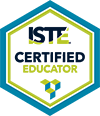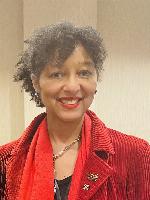Charting a Course to Tomorrow's Waters: Empowering Young Solutionary Minds
,
Snapshots are a pairing of two 20 minute presentations followed by a 5 minute Q & A.
This is presentation 2 of 2, scroll down to see more details.
Other presentations in this group:
- Presentation 1: Centering Ethics & Equity in the AI Age
Presenters



Session description
Purpose & objective
Purpose:
Our session is designed to empower educators to use the Solutionary Lens framework from the Institute for Humane Education. We delve into environmental challenges, focusing on sediment and bacterial pollution in our local river.
Objectives (Participant Outcomes):
Participants will learn from our year-long experience using the Solutionary Lens framework, gaining skills to guide students in critical analysis of real-world problems, considering the least harm and most good perspectives.
Participants will discover how digital tools such as Microsoft Sway and We Video were integrated into the learning experience as vehicles to allow for student voice and digital mastery.
Participants will explore collaborative learning models and strategies supporting language acquisition and accessibility. These methods sparked engaging student discussions, debates, and deep comprehension of the environmental topic.
The challenge addressed is to create engaging and inclusive environmental education experiences using the Solutionary Lens framework, ensuring students analyze problems from diverse perspectives. By using the framework, we had a guide to support our work so that we could give our students access to a relevant and meaningful problem based learning experience.
Technology Integration: During our presentation, we will share how we used the following technology: Microsoft Sway, Microsoft Teams, Gizmos, Minecraft EDU, WeVideo, Microsoft Search Coach, Various Multi-Media
We used the Solutionary Lens Framework from the Institute for Humane Education to guide our work.
Evidence of Success includes student engagement, quality artifacts that served a purpose to educate the community, transfer of skills seen in other domains.
Outline
Content and Activities:
Introductions: (5 minutes)
Icebreaker Activity: Participants pair up and discuss a real-world problem in their local environments. We will come together as a whole group and document what participants share.
Case Study Presentation: (40 minutes)
The participants will co-present the story of their year-long journey learning about the Solutionary Lens Framework from the Institute for Humane Development, and how they developed a unit using the framework as their guide. The case study will include all the steps that the facilitators took and the insights that they gained through each lesson. The participants will be able to view the students' final products that are their calls to action. Throughout the presentation, the facilitators will emphasize the strategies that they implemented from their background including English Language Learning Strategies and Universal Design Strategies. They will spend a longer amount of time on the 5 Why’s strategy since it will be included in audience engagement after the case study presentation has concluded. This will take approximately 40 minutes.
The 5 Whys: (7 minutes)
The facilitators will lead their participants through a strategy known as the 5 Whys, which is used by the Institute to help individuals get to the root cause of problems. We will review the strategy and share an example of student work. We will model with a problem selected by the audience and then have time for participants to try it themselves and then share out.
Reflection and Bridge to Practice: (8 minutes)
The session will end with a Q+A and reflection to bridge to practice discussion. This will be a whole-group conversation and an interactive space to capture all the ideas so that educators can learn from one another. To conclude, we will invite participants to share a takeaway. We will document and share out the resources.
Supporting research
The Institute for Humane Education - https://humaneeducation.org/
The World Becomes What We Teach - Zoe Weil
The Solutionary Guidebook For Educators Who Want To Change the World - https://humaneeducation.org/wp-content/uploads/2022/10/Solutionary-Guidebook_V3-2022.pdf
Schools Should Be Places of Joy - https://www.psychologytoday.com/intl/blog/becoming-a-solutionary/202309/schools-should-be-places-of-joy
Session specifications
Laptop: Chromebook, Mac, PC
Tablet: Android, iOS, Windows
Collaborator
- Use collaborative tools to expand students' authentic, real-world learning experiences by engaging virtually with experts, teams and students, locally and globally.
Creative Communicator
- Students publish or present content that customizes the message and medium for their intended audiences.
- Students use collaborative technologies to work with others, including peers, experts or community members, to examine issues and problems from multiple viewpoints.
 Return
Return Listen and learn: Snapshot
Listen and learn: Snapshot  Trips and Tours
Trips and Tours Recorded Session
Recorded Session Virtual Session
Virtual Session